How can we embed sustainability and responsibility at the core of our business?
This is the key question of many companies who are part of the sustainability transition journey.
There is, however, no single formula for sustainable value creation. Sustainability is a continuous process, not a fixed destination, and it varies depending on a company’s culture, ambitions, and market challenges.
Drawing from her extensive research into leading companies and sustainability champions for her internationally recognized book, The New Pioneers, Tania Ellis developed the 4Cs Model of Sustainable Business Success© – a strategic framework designed to help businesses align their operations with sustainability.
This framework consolidates best practices, tools, and guidelines for integrating sustainability into a systematic approach, organized around four essential cornerstones that guide businesses on their sustainability journey: Clear Purpose, Corporate Engagement, Collaborative Co-Creation, and Clear Communication.
Here’s how you can apply the 4Cs as guiding principles on the path to sustainable business success:
1. CLEAR PURPOSE
Clear Purpose is about embedding sustainability into your business by aligning your corporate strategy with sustainability and responsibility.
This cornerstone serves as overall strategic guidance and offers the opportunity to create a competitive advantage.
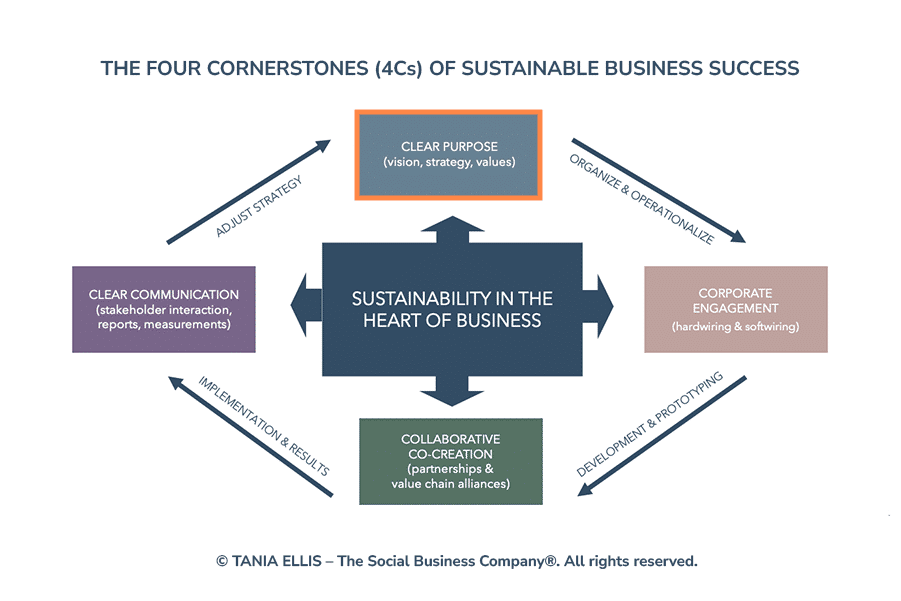
A key aspect of ‘Clear Purpose’ is selecting social and environmental activities that match your company’s competencies and reflect its culture, values, challenges, strategic goals and impact opportunities.
This requires a deep discussion around why you want to integrate sustainability into your business. Is it to comply with legislation, improve public relations, outpace competitors, develop new product lines, transform the entire business—or even disrupt your industry?
It may also imply a new vision of business outcomes and asking funadamental questions like:
- “What does sustainability mean to our business?”
- “How genuinely committed are we to creating sustainable value?
- “How much are we willing to invest before there is a return?”
Ultimately, this first cornerstone can only be enabled if company gatekeepers—CEOs, CFOs, and board members—give permission to and lead the change.
2. CORPORATE ENGAGEMENT
Corporate Engagement is about turning sustainable business strategies and ambitions into daily internal actions.
This cornerstone serves as guidance as to how a company can integrate sustainability and responsibility into the heart of its organization.
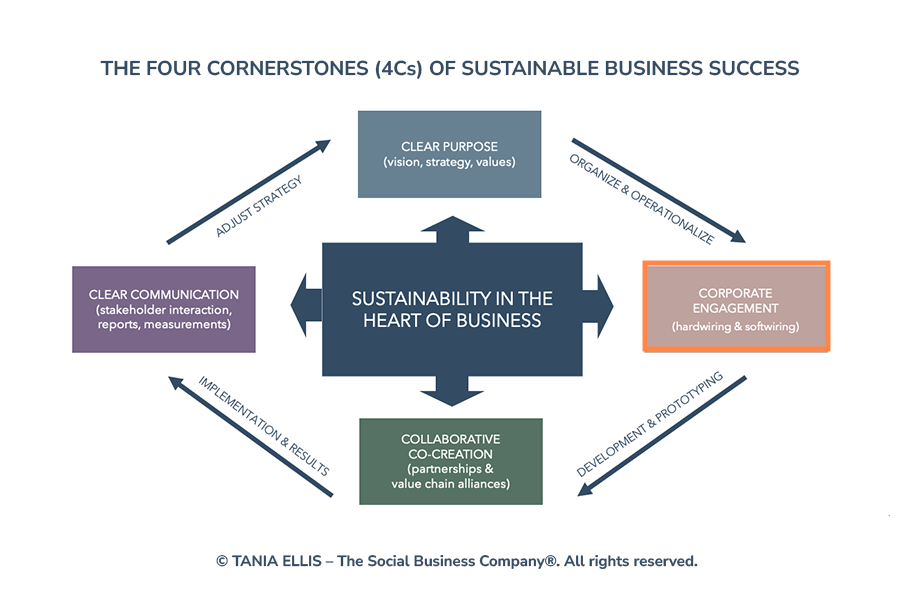
This part is about ensuring an effective implementation of your company’s ESG and sustainable business efforts through ‘hardwiring’ – governance structures, processes, performance metrics and measurement systems – and ‘softwiring’ – employee and leadership training, internal communications, engagement programmes and company culture.
This ensures that CSR ambitions become embedded in your company’s mindset, skills, and daily practices.
It’s also crucial to engage all divisions of the organization, such as sales, marketing, finance, and IT, so they are actively involved in ESG implementation and the development of sustainability initiatives.
In addition to top management, key catalysts include sustainability managers, HR directors, external consultants, and dedicated intrapreneurs.
Embedding corporate responsibility and sustainability throughout the company ensures higher employee engagement and a stronger employer brand—and may ultimately pave the way for sustainable business development and corporate social innovation.
3. COLLABORATIVE CO-CREATION
Collaborative Co-Creation is about embedding sustainability and responsibility into business operations by transforming external stakeholders into potential shared value partners.
It goes beyond due diligence and risk management—it’s about building alliances across the company’s value chain to create sustainable value. By inviting stakeholders to collaborate on positive impact and innovation, they become co-creators of both social and business value, benefiting all involved.
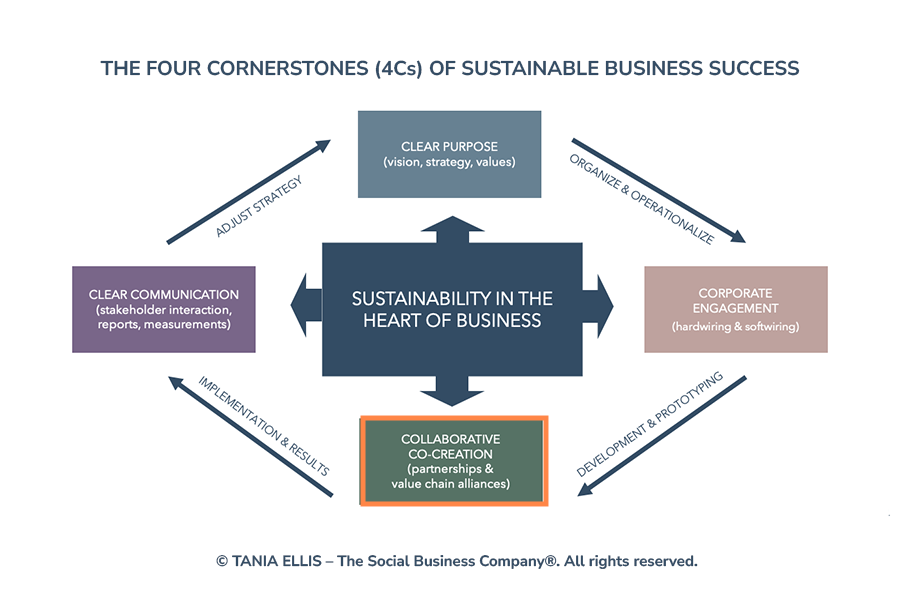
Your stakeholders bring unique knowledge that can enhance business activities, while introducing new mindsets, values, and energy to mainstream companies.
Potential collaborators include local citizens and grassroots initiatives; impact entrepreneurs with ready-made solutions; opinion-makers or specialist consultants who offer fresh ideas and insights; NGOs or academic institutions with specialized knowledge; and even other companies—including competitors—with complementary core competencies.
This third enabling C requires both technology and people within your company who possess the necessary expertise in networking, stakeholder management, and specialist skills to build successful partnerships.
4. CLEAR COMMUNICATION
Clear Communication is about communicating your corporate sustainability and responsibility efforts – the successes as well as the failures – in an open, transparent and engaging way.
Mastering this cornerstone helps build trust, mutual understanding, and your corporate brand, while also gathering valuable ideas and feedback from both internal and external stakeholders.
It gives your business legitimacy – and demands authenticity.
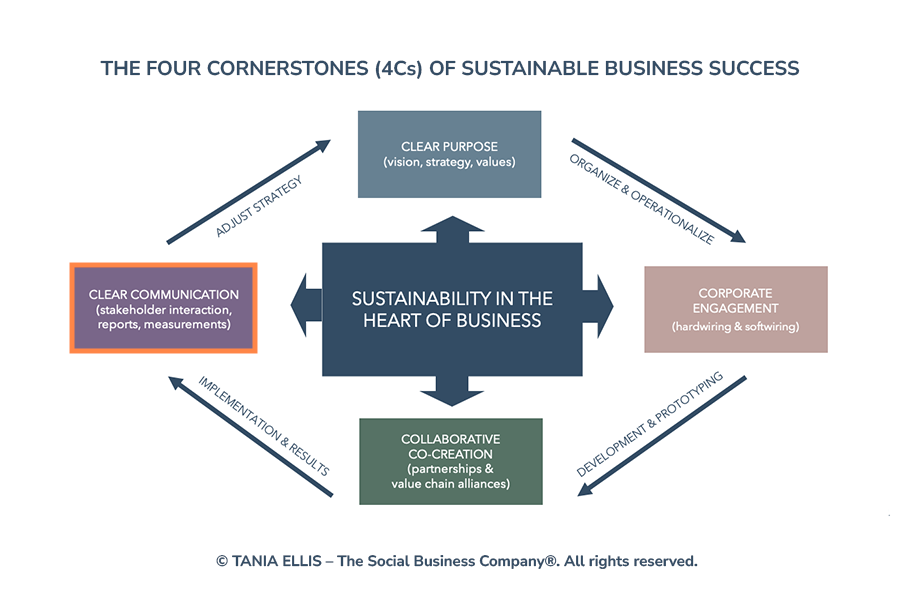
In practice, this involves using a mix of traditional channels—like your company website, PR, and ads—alongside interactive platforms such as social media to foster stakeholder engagement, collect feedback, and facilitate internal communication.
By combining these communication methods, your company can react quickly to challenges and take advantage of stakeholder insights. Openness and transparency in sharing both achievements and setbacks are critical to building the trust and understanding that support long-term sustainable business success.
Key communication tools include annual ESG and sustainability reports, corporate websites, PR, blogs, social media, and online forums. Public engagement through speeches, articles, and contributions by key company figures—especially the CEO—further strengthens authenticity and credibility.
The 4Cs Model of Sustainable Business Success is a strategic framework designed to help businesses align their business strategy and operations with sustainability. Want to learn more about how to apply the 4Cs in practice? Explore our Academy, Consulting, Club and Speaking services.






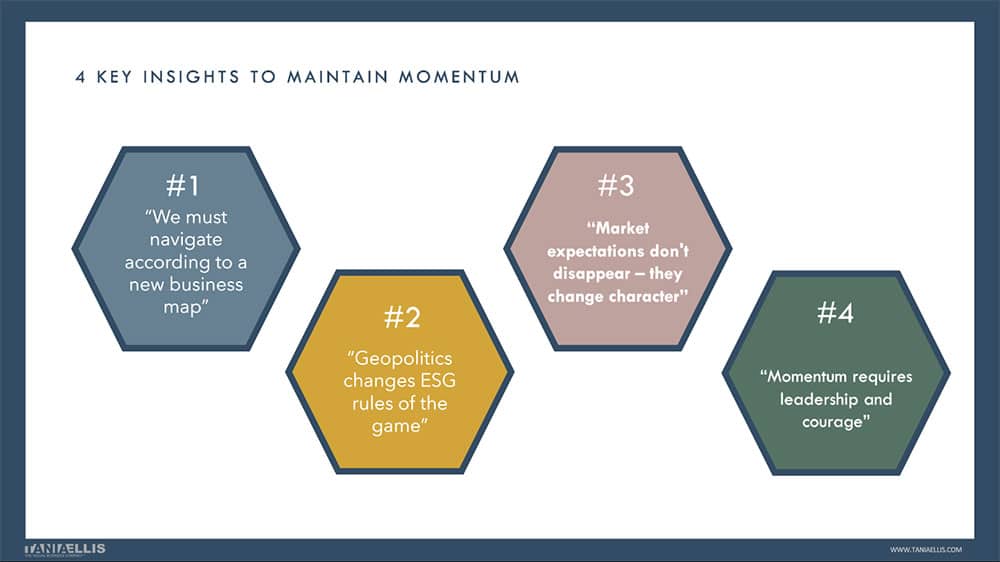
![[Portrait] A change agent’s experience: From scattered ESG initiatives to strategic direction](https://www.taniaellis.com/wp-content/uploads/2025/10/baeredygtighed-i-praksis-case-website_ny-1080x675.jpg)